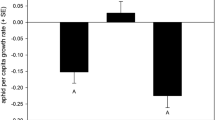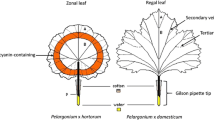Abstract
Rhinoncomimus latipes is a monophagous weevil used as a biological control agent for Persicaria perfoliata in the eastern United States. Density of adult R. latipes and resulting feeding damage has been shown to be higher in the sun than in the shade. This study aimed to determine whether phototaxis, sensitivity to enhanced host cues from healthier sun-grown plants, or a combination is driving this behavior by the weevil. A series of greenhouse choice tests between various combinations of plant and light conditions showed that R. latipes is positively phototactic, responsive to host cues, and preferentially attracted to sun-grown plants over shade-grown plants. From our experiments, we hypothesize two phases of dispersal and host finding in R. latipes. The initial stage is controlled primarily by phototaxis, whereas the later stage is controlled jointly by host cues and light conditions.


Similar content being viewed by others
References
Addesso KM, McAuslane HJ (2009) Pepper weevil attraction to volatiles from host and nonhost plants. Environ Entomol 38:216–224
Atkins MD (1980) Introduction to insect behavior. Macmillan Publishing Co., New York
Björklund N, Nordlander G, Bylund H (2005) Olfactory and visual stimuli used in orientation to conifer seedlings by the pine weevil, Hylobius abietis. Physiol Entomol 30:225–231
Bruce TJA, Pickett JA (2011) Perception of plant volatile blends by herbivorous insects–finding the right mix. Phytochemistry 72:1605–1611
Colpetzer K, Hough-Goldstein J, Ding J, Fu W (2004) Host specificity of the Asian weevil, Rhinoncomimus latipes Korotyaev (Coleoptera: Curculionidae), a potential biological control agent of mile-a-minute weed, Polygonum perfoliatum L. (Polygonales: Polygonaceae). Biol Control 30:511–522
Cornelissen T, Fernandes GW, Vasconcellos-Neto J (2008) Size does matter: variation in herbivory between and within plants and the plant vigor hypothesis. Oikos 117:1121–1130
Cross WH, Mitchell H, Hardee D (1976) Boll weevils: response to light sources and colors on traps. Environ Entomol 5:565–571
EDDMapS (2012) Center for invasive species and ecosystem health: early detection and distribution mapping system. University of Georgia URL: http://www.eddmaps.org/distribution/uscounty.cfm?sub=3065 (accessed 5.11.12)
Finch S, Collier RH (2000) Host-plant selection by insects—a theory based on ‘appropriate/inappropriate landings’ by pest insects of cruciferous plants. Entomol Exp Appl 96:91–102
Finch S, Collier RH (2012) The influence of host and non-host companion plants on the behavior of pest insects in field crops. Entomol Exp Appl. doi:10.1111/j.1570-7458.2011.01191.x
Frye MJ, Lake EC, Hough-Goldstein J (2010) Field host-specificity of the mile-a-minute weevil, Rhinoncomimus latipes Korotyaev (Coleoptera: Curculionidae). Biol Control 55:234–240
Hollingsworth JP, Wright R, Lindquist D (1964) Spectral response characteristics of the boll weevil. J Econ Entomol 57:38–41
Hough-Goldstein J (2008) Assessing herbivore impact on a highly plastic annual vine. In: Julian MH, Sforza R, Bon MC, Evans HC, Hatcher PE, Hinz HL, Rector BG (eds) Proceedings of the XII International Symposium on Biological Control of Weeds, La Grande Motte, France, 22–27 April 2007. CAB International, Wallingford, pp 283–286
Hough-Goldstein J, LaCoss S (2012) Interactive effects of light environment and herbivory on growth and productivity of an invasive annual vine, Persicaria perfoliata. Arthropod-Plant Interactions 6:103–112
Hough-Goldstein J, Lake E, Reardon R, Wu Y (2008) Biology and biological control of mile-a-minute weed, USDA Forest Service, FHTET-2008-10, Morgantown, WV
Hough-Goldstein J, Lake E, Reardon R (2012) Status of an ongoing biological control program for the invasive vine, Persicaria perfoliata in eastern North America. BioControl 57:181–189
Jermy T, Szentesi A, Hovath J (1988) Host plant finding in phytophagous insects: the case of the Colorado potato beetle. Entomol Exp Appl 49:83–98
Johnson C (1963) Physiological factors in insect migration by flight. Nature 198:423–427
Kjaer-Pedersen C (1992) Flight behaviour of the cabbage seedpod weevil. Entomol Exp Appl 62:61–66
Korotyaev BA (2006) A review of the weevil genus Rhinoncomimus Wagner (Coleoptera: Curculionidae: Ceutorhynchinae). Entomol Abh 63:99–122
Kumar V, Ditommaso A (2005) Mile-a-minute (Polygonum perfoliatum): an increasingly problematic invasive species. Weed Technol 19:1071–1077
Lake EC, Hough-Goldstein J, Shropshire KJ, D’Amico V (2011) Establishment and dispersal of the biological control weevil Rhinoncomimus latipes on mile-a-minute weed, Persicaria perfoliata. Biol Control 58:294–301
McKibben GH, Mitchell EB, Scott WP, Hedin PA (1977) Boll weevils are attracted to volatile oils from cotton plants. Environ Entomol 6:804–806
Meyer JR (1976) Positive phototaxis of adult alfalfa weevils to visible and near-infrared radiation. Ann Entomol Soc Am 69:21–25
Mitchell ER, Taft HM (1966) Host plant selection by migrating boll weevils. J Econ Entomol 59:390–392
Moul ET (1948) A dangerous weedy Polygonum in Pennsylvania. Rhodora 50:64–66
Mountain WL (1989) Mile-a-minute (Polygonum perfoliatum L.) update- distribution, biology, and control suggestions. Regul Hortic 15:21–24
Oliver JD (1996) Mile-a-minute weed (Polygonum perfoliatum L.), an invasive vine in natural and disturbed sites. Castanea 61:244–251
Price PW (1991) The plant vigor hypothesis and herbivore attack. Oikos 62:244–251
Prokopy RJ, Gyrisco GG (1965) Diel flight activity of migrating alfalfa weevils, Hypera postica (Coleoptera: Curculionidae). Ann Entomol Soc Am 58:642–647
Reeves JL, Lorch PD (2011) Visual active space of the milfoil weevil, Euhrychiopsis lecontei Dietz (Coleoptera: Curculionidae). J Insect Behav 24:264–273
Schoonhoven LM, van Loon JJA, Dickie M (2005) Insect-plant biology. Oxford University Press, New York
Szendrei Z, Malo E, Stelinski L, Rodriguez-Saona C (2009) Response of cranberry weevil (Coleoptera: Curculionidae) to host plant volatiles. Environ Entomol 38:861–869
Tinbergin N (1951) The study of instinct. Clarendon, Oxford
Acknowledgments
We thank White Clay Creek State Park for allowing us to collect weevils and seeds from their land. Additionally, we thank Kaity Handley and Connie Gatlin for helping to set up and monitor experiments as well as Bill Bartz and Rodney Dempsey for their expertise and help with designing greenhouse protocols. Funding was provided by the USDA Forest Service.
Author information
Authors and Affiliations
Corresponding author
Rights and permissions
About this article
Cite this article
Smith, J.R., Hough-Goldstein, J. Phototaxis, Host Cues, and Host-Plant Finding in a Monophagous Weevil, Rhinoncomimus latipes . J Insect Behav 26, 109–119 (2013). https://doi.org/10.1007/s10905-012-9343-7
Revised:
Accepted:
Published:
Issue Date:
DOI: https://doi.org/10.1007/s10905-012-9343-7




